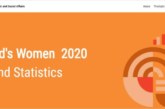By FGR Bureau
“The ESCAP Social survey talks about ‘Ambitions beyond growth’. The Assessments are done, Agenda is set, what is important now is the deciding the Future discourse which shall embank on the prospects of Asia-Pacific region towards securing SDG 6”.
A comprehensive assessment underlined in ESCAP shows the Asia-Pacific region needs to invest an additional $1.5 trillion every year to reach the Goals by 2030. Further, an additional investment of $434 billion per year would be needed for clean energy and climate-resilient infrastructure. With South Asian Region between 1970 and 2016 witnessing losses and damage equivalent to $1.3 trillion due to disasters, including floods, storms, droughts, earthquakes and tsunami. Pollution and climate change adversely affect the agricultural sector due to declining soil productivity, groundwater depletion and increased incidence of pests. How can we reverse such hazards? The damage cannot be reversed but the future disasters can be prevented to a larger extent.
To secure a climate-resilient future, urgent action is needed, which entails an annual incremental expenditure of $616 billion. This investment would help the Asia-Pacific region contribute to keeping the global temperature rise well below two degrees Celsius by the end of the century compared with the preindustrial level, as enshrined in the Paris Agreement. It not only mitigates climate risks by increasing the use of renewable energy and improving energy efficiency, but it also adapts the economies in the region to rising climate-induced disaster events
 A disturbing fact is that lack of community ownership and incentives for households to invest in sanitation are some examples of why water and sanitation targets are not reached. Raising awareness on the risks to health posed by open defecation and investing in behavior change related to hygienic practices have proven to be more efficient. The absence of clean drinking water leads to 80% of the illnesses prevalent in rural India. Sustainable interventions can only be achieved through education, empowerment and ownership by the rural community. Asia-Pacific developing countries need an additional $14 billion annually to provide universal access to water and sanitation by 2030. Progressive & Learning Environment outcomes through qualitative behavioral change, Knowledge exchange among stakeholders and disseminating scientific literacy holds the key to bring qualitative life among the rural community.
A disturbing fact is that lack of community ownership and incentives for households to invest in sanitation are some examples of why water and sanitation targets are not reached. Raising awareness on the risks to health posed by open defecation and investing in behavior change related to hygienic practices have proven to be more efficient. The absence of clean drinking water leads to 80% of the illnesses prevalent in rural India. Sustainable interventions can only be achieved through education, empowerment and ownership by the rural community. Asia-Pacific developing countries need an additional $14 billion annually to provide universal access to water and sanitation by 2030. Progressive & Learning Environment outcomes through qualitative behavioral change, Knowledge exchange among stakeholders and disseminating scientific literacy holds the key to bring qualitative life among the rural community.
At $1 per person per day, this investment is worthwhile. It could end extreme poverty and malnutrition for more than 400 million people. The survey proposes to move away from a model of Profit maximization to one that puts Purpose at its core. For this, the basic essence is securing water as Human Right. Securing human right to safe drinking water must place obligation on States to ensure that services are affordable. It is now widely recognized that the primary determinant for addressing the issues of global poverty is the provision of safe water; access to safe water enhances the potential for educational opportunities (particularly for girls) and facilitates participation in local community economic development.
The survey also recommends Resource efficiency to climate change mitigation programmes based on innovative techniques and technology. Scientific concepts like NEWater, green infrastructure, circular approach holds high potential to revive the water economy and necessary to meet future water demands. Goal 6 must call for water use efficiency, water quality and water resource management to help conserve water-related ecosystems. Nature based solutions like recharge of natural aquifers, community conservation water bodies, Integrated Water Shed Management, Eco-system based Adaptation, restoring wetlands, water-food-energy nexus should be adopted.
Estimating the financial costs of achieving SDGs by investing in people and planet is important to finance sustainable projects to realize basic human capacities, secure humanity’s future and enable us to live in harmony with nature. Mobilizing financial resources requires a concerted effort harnessing public resources, leveraging the private sector and promoting development partnerships and regional cooperation. Further, Scaling up partnerships by way of Convergence between the stakeholders, governments, civil society in the Asia-Pacific region. The rationale behind such strategy is to harness different stakeholder synergies and improving planning and implementation and outcomes.
Breaking the policy constraints is the hourly need to bring in requisite framework. For example; water legislation must prioritize water use for domestic consumption over other uses. A well-designed policy needs to have a substantive vision accompanied by assessment, monitoring and evaluation for cost effective benefits so that they can be appropriately improved based on an assessment of feedback mechanisms.
How do we make world a better place to live? These ‘ambitions beyond growth’ must encompass Access, Availability & Affordability of resources and services. Only then these Ambitions can translate into Actions & Outcomes to include socio-economic development. We must ensure that every individual and countries collaborate and cooperate working together to ensure ‘No One is Left Behind’ in this journey of sustainable development.


